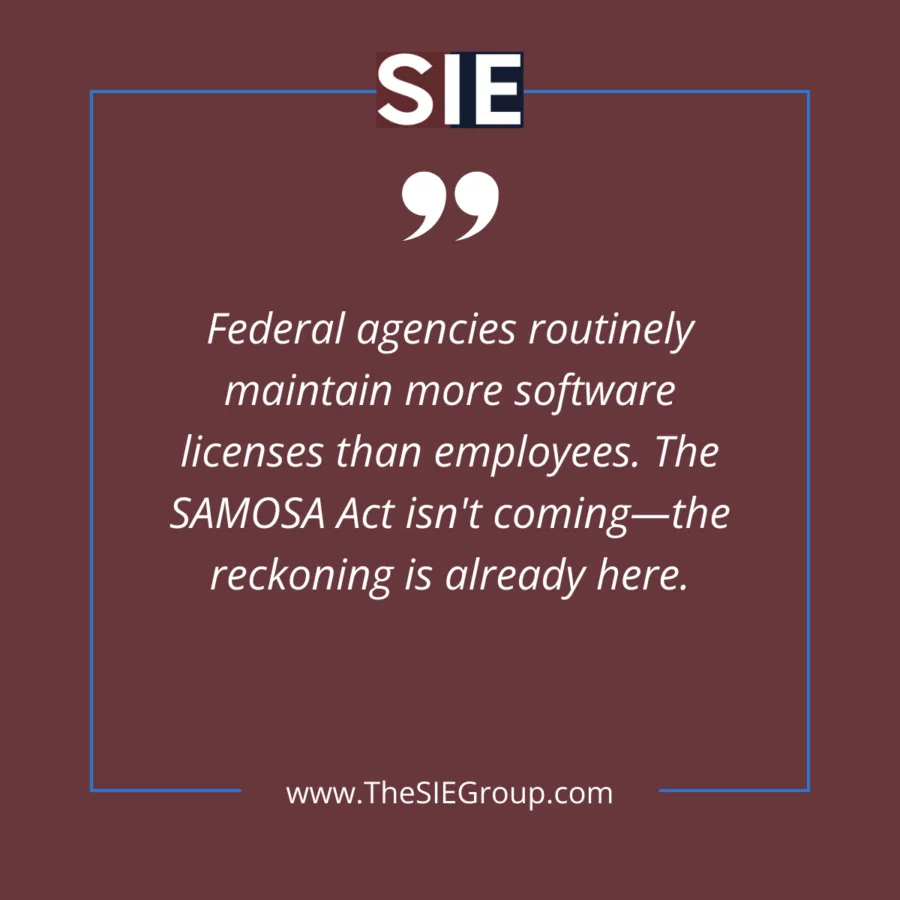SAMOSA Act 2025: How DOGE's Software Waste Findings Create New Urgency for Federal IT Asset Management
The federal government's software licensing practices just received their harshest spotlight yet. With Trump's Department of Government Efficiency (DOGE) uncovering shocking examples of software waste—including 37,000 WinZip licenses for just 13,000 GSA employees—the reintroduced Strengthening Agency Management and Oversight of Software Assets (SAMOSA) Act has gained unprecedented momentum in 2025.
Why 2025 Is Different for the SAMOSA Act
This marks the third time lawmakers have introduced the SAMOSA Act, but several factors make 2025 uniquely positioned for success:
Executive Branch Alignment: Unlike previous iterations, federal CIO Greg Barbaccia has already demanded comprehensive software inventories from all agencies by April 30, 2025. This executive pressure creates implementation momentum that didn't exist in prior Congressional sessions.
DOGE Political Cover: The bipartisan nature of addressing software waste has gained new political urgency. When DOGE can point to specific examples of excess licenses, the abstract concept of "government efficiency" becomes tangible for lawmakers and taxpayers alike.
Senate Leadership: Senator Joni Ernst, chair of the newly formed Senate DOGE Caucus, has made the SAMOSA Act a centerpiece of her efficiency agenda. Her leadership provides dedicated Senate advocacy that previous versions lacked.
Industry Mobilization: Technology trade associations, including the Coalition for Fair Software Licensing and Computer & Communications Industry Association, have coordinated their support more effectively, recognizing the alignment between DOGE's findings and their advocacy goals.
We previously discussed how the SAMOSA Act aligns with DOGE's efficiency mission—these new findings provide the concrete evidence validating that strategic alignment.
Implementation Timeline and Requirements
If enacted, the SAMOSA Act would require federal agencies to complete comprehensive software assessments within 18 months, followed by modernization plans within an additional year. This timeline presents both opportunities and challenges for federal IT teams.
Chief Information Officer Responsibilities would include:
- Conducting inventory of largest software entitlements by provider and category
- Documenting additional costs like cloud service fees not included in initial contracts
- Identifying restrictive licensing provisions that limit agency flexibility
- Developing enterprise licensing consolidation strategies
Office of Management and Budget
must publish a government-wide software modernization strategy based on agency assessments, marking a shift toward centralized coordination that could significantly impact how agencies approach vendor relationships.
Strategic Implications for Federal IT Leaders
The convergence of SAMOSA Act requirements and DOGE scrutiny creates both pressure and opportunity for federal IT teams. Agencies that proactively address software asset management will be better positioned to demonstrate efficiency and avoid negative attention.
Immediate Action Items
for federal IT leaders should include:
- Conducting preliminary software license audits before formal SAMOSA Act requirements
- Identifying vendor lock-in situations that limit competitive alternatives
- Evaluating enterprise licensing opportunities across common software categories
- Establishing baseline metrics for software utilization and cost per user
Long-term Strategic Considerations involve moving beyond compliance toward optimization. The most successful agencies will view the SAMOSA Act not as a burden but as framework for achieving better vendor negotiations, improved cost visibility, and enhanced operational efficiency.
Cybersecurity and Compliance Benefits
Beyond cost savings, improved software asset management directly supports federal cybersecurity objectives. When agencies maintain accurate inventories and eliminate unused licenses, they reduce their attack surface and improve patch management processes.
The SAMOSA Act's emphasis on standardized practices also aligns with broader federal initiatives around zero trust architecture and supply chain security. Agencies with better software visibility can more effectively assess vendor risk and maintain compliance with evolving cybersecurity requirements.
Preparing for Implementation
Federal IT teams should begin preparation regardless of final passage timing. The momentum behind the SAMOSA Act—driven by DOGE findings and bipartisan Congressional support—suggests that enhanced software oversight is inevitable.
Assessment Preparation
involves cataloging current software deployments, understanding licensing terms and restrictions, and identifying opportunities for consolidation. Agencies that start this work early will be better positioned to meet eventual requirements efficiently.
Vendor Relationship Strategy
requires evaluating current contracts for flexibility and competitive alternatives. The emphasis on reducing vendor lock-in means agencies should prioritize solutions that maintain negotiating leverage.
Looking Ahead
The SAMOSA Act represents more than software management reform—it signals a broader shift toward data-driven efficiency in federal operations. With DOGE providing concrete examples of waste and bipartisan Congressional support, 2025 appears positioned for meaningful change in how agencies approach technology procurement and management.
Federal IT leaders who embrace this shift proactively will find themselves better positioned to demonstrate value, secure resources, and support their agencies' missions effectively. The question isn't whether enhanced software oversight is coming—it's whether your agency will be ready to lead or scrambling to catch up.
Ready to strengthen your agency's software asset management program? Contact our team for strategic guidance on SAMOSA Act compliance and federal IT asset management best practices.
Want to discuss your agency's preparation strategy? Schedule a conversation
with our federal ITAM experts to explore solutions for your compliance objectives.
